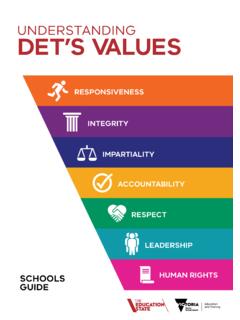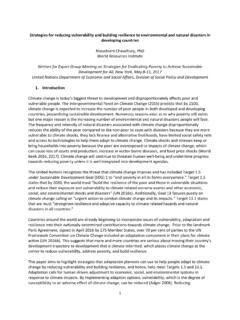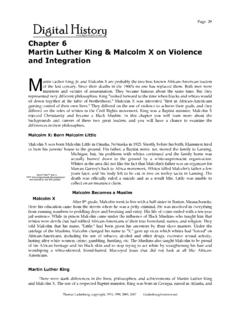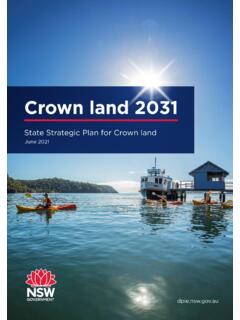Transcription of What is a Comprehensive Plan?
1 In many communities throughout Pennsylvania, the vision for future growth and development is outlined in a Comprehensive Plan. Comprehensive Plans are the backbone of any community planning effort. They outline challenges facing the community, identify solutions, and provide guidance to appointed and elected officials on planning-related decisions. The best Comprehensive Plans are those that have the support of the broader community. They are a living document that grows and changes with the community. The purpose of this handout is to provide course participants with supplemental information on Comprehensive Plans and detailed information on the Centre Region s most recent planning endeavors.
2 Community planning, according to the American Planning Association, is a process that seeks to engage all members of the community to create a more prosperous , convenient, equitable, healthy, and attractive place for present and future generations. One of the fundamental responsibilities of local government is to plan for future growth and development of the community. The guidance document that results from this planning process is the Comprehensive plan. In Pennsylvania, municipalities are enabled by the Municipalities Planning Code (MPC) to create Comprehensive plans to guide growth and development for their jurisdictions. The term Comprehensive plan is not defined in the MPC.
3 Comprehensive plans are defined by their contents, which are intended to proactively and comprehensively address future growth and development. Proactive planning is important for local governments because without it, the ability to plan is given to others who may not have the best interests of the municipality in mind. A Comprehensive plan provides a vision for the future of the community along with the steps that are needed to make that vision a reality. It is the basis for land use regulations and provides a nexus between the community s future vision and the regulation of private property. This framework helps guide growth and change but without it, the development process would be reactive, resulting in development that is uncoordinated and costly.
4 The Comprehensive plan is a recommendatory document, providing guidance and is often written abstractly so that appointed and elected officials can utilize a variety of means to implement it. While only recommendatory in nature, the value of a Comprehensive plan is indicated by the community s desire to see to its implementation. It is important to remember that a Comprehensive plan and a zoning ordinance are two separate tools that are used in conjunction with one another. A Comprehensive plan acts in a guiding role and provides recommendations on how land should be utilized to meet the needs and desires of the community, whereas a zoning ordinance regulates land uses as recommended by the plan.
5 1 What is a Comprehensive Plan? Enabling Legislation Article III of the Pennsylvania Municipalities Planning Code outlines the requirements for preparing, adopting, and implementing a municipal, multi-municipal, or county Comprehensive plan. Although the MPC does not provide an actual definition for what a Comprehensive plan is, this section of the MPC clearly outlines what a plan should contain and its legal status. The MPC also includes references to Comprehensive plans throughout its other articles. In recent decades, the MPC was modified to permit greater collaboration amongst municipalities that are contiguous or located within the same school district boundaries. These improvements have encouraged and allowed for greater cooperation in multi-municipal planning.
6 Comprehensive Plan Types The MPC outlines four different types of Comprehensive plans including municipal, multi-municipal, county, and specific plans. These plan types are defined as follows: Municipal A plan that is limited to a single municipality. Multi-municipal A plan developed and adopted by any number of contiguous municipalities, including a joint municipal plan as authorized by this act, except that all of the municipalities participating in the plan need not be contiguous if all of them are within the same school district. County A land use and growth management plan prepared by the county planning commission and adopted by the county commissioners which establishes broad goals and criteria for municipalities to use in preparation of their Comprehensive plan and land use regulation.
7 Specific - a detailed plan for nonresidential development of an area covered by a municipal or multi-municipal Comprehensive plan, which when approved and adopted by the participating municipalities through ordinances and agreements, supersedes all other applications. All Comprehensive plans must meet the same four criteria. Those criteria include: 1. Contain basic plan elements set forth in Section 301(a) of the MPC. 2. Contain a plan for reliable supply of water, considering current and future water resources availability. 3. Be reviewed every 10 years. 4. Identify those areas where growth and development will occur so that a full range of public infrastructure, including sewer, water, highways, police and fire protection, public schools, parks, open space, and other services can be adequately planned and provided as needed to accommodate growth.
8 Because this document is focused on Comprehensive planning in the Centre Region, the majority of the information shared in this handout will focus on municipal and multi-municipal Comprehensive plans. 2 Components of a Comprehensive Plan Article III, Section 301 (a) of the MPC defines minimum requirements for what a municipal, multi-municipal, or county Comprehensive plan must contain. These minimum requirements can be exceeded based upon the desire of the community for which it is being prepared. The following requirements are listed in Section 301 (a) of the MPC: (a) The municipal, multi-municipal, or county Comprehensive plan, consisting of maps, charts, and textual matter, shall include, but need not be limited to the following related basic elements: (1) A statement of objectives of the municipality concerning its future development, including but not limited to, the location, character, and timing of future development that may also serve as a statement of community development objectives as provided in section 606.
9 (2) A plan for land use, which may include provisions for the amount, intensity, character, and timing of land use proposed for residence, industry, business, agriculture, major traffic and transit facilities, utilities, community facilities, public grounds, parks and recreation, preservation of prime agricultural lands, flood plains, and other areas of special hazards and other similar uses. ( ) A plan to meet the housing needs of present residents and of those individuals and families anticipated to reside in the municipality, which may include conservation of presently sound housing, rehabilitation of housing in declining neighborhoods, and the accommodation of expected new housing in different dwelling types and at appropriate densities for households of all income levels.
10 (3) A plan for movement of people and goods, which may include expressways, highways, local street systems, parking facilities, pedestrian and bikeway systems, public transit routes, terminals, airfields, port facilities, railroad facilities, and other similar facilities or uses. (4) A plan for community facilities and utilities, which may include public and private education, recreation, municipal buildings, fire and police stations, libraries, hospitals, water supply and distribution, sewage and waste treatment, solid waste management, storm drainage, flood plain management, utility corridors and associated facilities, and other similar facilities or uses. ( ) A statement of the interrelationships among the various plan components, which may include an estimate of the environmental, energy conservation, fiscal, economic development, and social consequences of the municipality.








